2003 PONTIAC BONNEVILLE tire pressure
[x] Cancel search: tire pressurePage 325 of 418
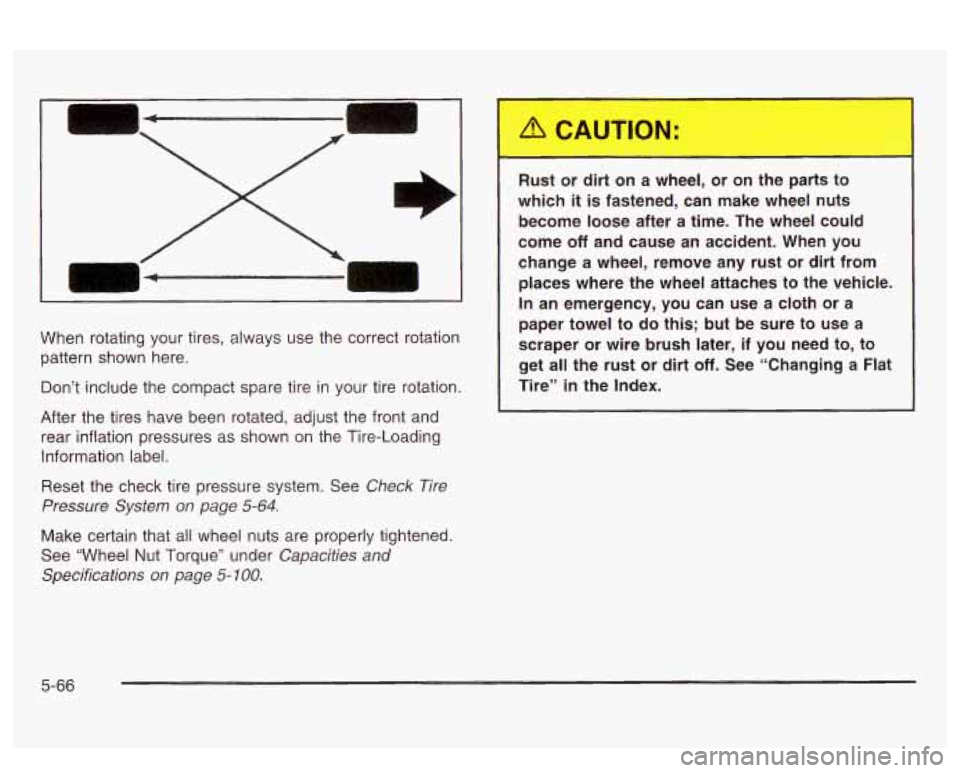
When rotating your tires, always use the correct rotation
pattern shown here.
Don’t include the compact spare tire in your tire rotation.
After the tires have been rotated, adjust the front and
rear inflation pressures as shown on the Tire-Loading
Information label.
Reset the check tire pressure system. See
Check Tire
Pressure System on page
5-64.
Make certain that all wheel nuts are properly tightened.
See “Wheel Nut Torque” under
Capacities and
Specifications on page
5- 100.
Rust or dirt on a wheel, or on the parts to
which
it is fastened, can make wheel nuts
become loose after a time. The wheel could
come
off and cause an accident. When you
change a wheel, remove any rust or dirt from
places where the wheel attaches to
the vehicle.
In an emergency, you can use a cloth or a
paper towel to do this; but be sure to use a
scraper or wire brush later, if you need
to, to
get all the rust or dirt
off. See “Changing a Flat
Tire”
in the Index.
5-66
Page 331 of 418
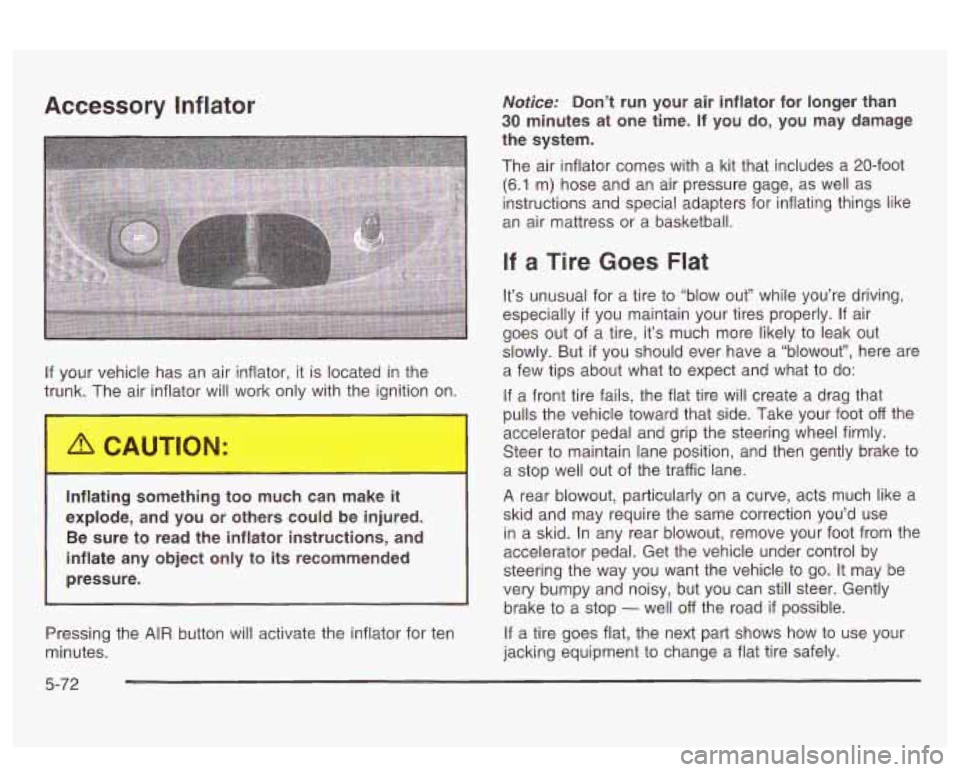
Accessory Inflator
If your vehicle has an air inflator, it is located in the
trunk. The air inflator will wo only with the ignition on.
Inflating something too much can make it
explode, and you or others could be injured.
Be sure to read the inflator instructions, and
inflate any object only to its recommended
pressure.
I -1
Notice: Don’t run your air inflator for longer than
30 minutes at one time. If you do, you may damage
the system.
The air inflator comes with a kit that includes a 20-foot
(6.1 m) hose and an air pressure gage, as well as
instructions and special adapters for inflating things like
an air mattress or a basketball.
If a Tire Goes Flat
It’s unusual for a tire to “blow out” while you’re driving,
especially
if you maintain your tires properly. If air
goes out of a tire, it’s much more likely to leak out
slowly. But
if you should ever have a “blowout”, here are
a few tips about what to expect and what to do:
If a front tire fails, the flat tire will create a drag that
pulls the vehicle toward that side. Take your foot off the
accelerator pedal and grip the steering wheel firmly.
Steer to maintain lane position, and then gently brake to
a stop well out of the traffic lane.
A rear blowout, particularly on a curve, acts much like a
skid and may require the same correction you’d use
in a skid. In any rear blowout, remove your foot from the
accelerator pedal. Get the vehicle under control by
steering the way you want the vehicle to go.
It may be
very bumpy and noisy, but you can still steer. Gently
brake
to a stop - well off the road if possible.
Pressing the
AIR button will activate the inflator for ten If a tire goes flat, the next part shows how to use your
minutes. jacking equipment to change a flat tire safely.
5-72
Page 340 of 418

/
.B
C
I
I E
I I
A. Wrench
B. Jack
C. Jack Container
D. Retainer
E. Compact Spare Tire Cover
F. Retainer
Compact Spare Tire
Although the compact spare tire was fully inflated when
Check the inflation pressure regularly. It should be
60 psi (420 kPa).
..^..I yuul vehicle was iievi, it mi7 lose air after a tine. After
installing the compact spare on your vehicle, you
should stop as soon as possible and make sure
your spare tire is correctly inflated. The compact spare
is made to perform well at speeds up to 65 mph
(105 km/h) for distances up to 3,000 miles (5 000 km)~
so you can finish your trip and have your full-size
tire repaired or replaced where you want. You must:
calibrate the Check Tire Pressure System after installing
or removing the compact spare. See
Check Tire
Pressure
System on page 5-64. Of course, it’s best to
replace your spare with a full-size tire as soon as
you can. Your spare will last longer and be in good
shape in case you need
it again.
Notice: When the compact spare is installed, don’t
take your vehic!e through
an automatic car wash
with guide rails. The compact spare can get caught on the rails. That can damage the tire and wheel,
and maybe other parts
of your vehicle.
Don’t use your compact spare on other vehicles.
And don’t mix your compact spare tire or wheel with
spare tire and its wheel together.
ether t!!hee!s ?irks. The;/ w~n’t fit. Kppp yncIr Cnmrpct
Nofice: Tire chains won’t fit your compact spare.
Using them can damage your vehicle and can
damage the chains too. Don’t use tire chains on
your compact spare.
5-81
Page 368 of 418

Footnotes
t The U.S. Environmental Protection Agency or the
California Air Resources Board has determined that the
failure to perform this maintenance item will not nullify
the emission warranty or limit recall liability prior to
the completion of the vehicle
's useful life. We, however,
urge that all recommended maintenance services be
performed at the indicated intervals and the
maintenance be recorded.
*If your vehicle has the GM Oil Life SystemTM,
a
computer system lets you know when to change the oil
and filter. This is based on engine revolutions and
engine temperature and not on mileage. Based
on driving conditions, the mileage at which an oil change
will be indicated can vary considerably. For the oii life
system to work properly, you must reset the system
every time the oil is changed.
When the system has calculated that oil life has been
diminished, it will indicate that an oil change is
necessary. An ENGINE
OIL CHANGE SOON message
will come on. Change your oil as soon as possible
within the next two times you stop for fuel. It is possible
that, if you are driving under the best conditions, the
oil life system may not indicate that an oil change
is necessary for over a year. However, your engine oil
and filter must be changed at least once a year and
at this time the system must be reset. It is also
important to check your oil regularly and keep it at the
proper level.
If the system is ever reset accidentally, you must
change your oil at 3,000 miles
(5 000 km) since your
last oil change. Remember to reset the oil life system
whenever the oil is changed. See Engine Oil on
page
5-15 for information on resetting the system.
@ Whenever the tires are rotated, the Check Tire
Pressure §ystem must be reset.
+A good time to check your brakes is during tire
rotation. See Brake System Inspection on page 6-23.
3,000 Miles (5 000 km)
0 Change engine oil and filter (or every 3 months,
whichever occurs first).
An Emission Control Service.
(See footnote
*.)
6,000 Miles (IO 000 km)
u
n U
Change engine oil and filter (or every 3 months,
whichever occurs first).
An Emission Control Service.
(See footnote
*.)
page 5-65 for proper rotation pattern and additional
information.
(See footnote @.) (See footnote +.)
n-4-4- r?-- -I-:-- I 4:-- -...A n-+-+:-- -- I wlalc LII ~a. UGG I 11 G 11 I~JG~LIVII a1 IU I IvLauvII VII
9,000 Miles (15 000 km)
U Change engine oil and filter (or every 3 months,
whichever occurs first).
An Emission Control Service.
(See footnote
*.)
6-7
Page 373 of 418
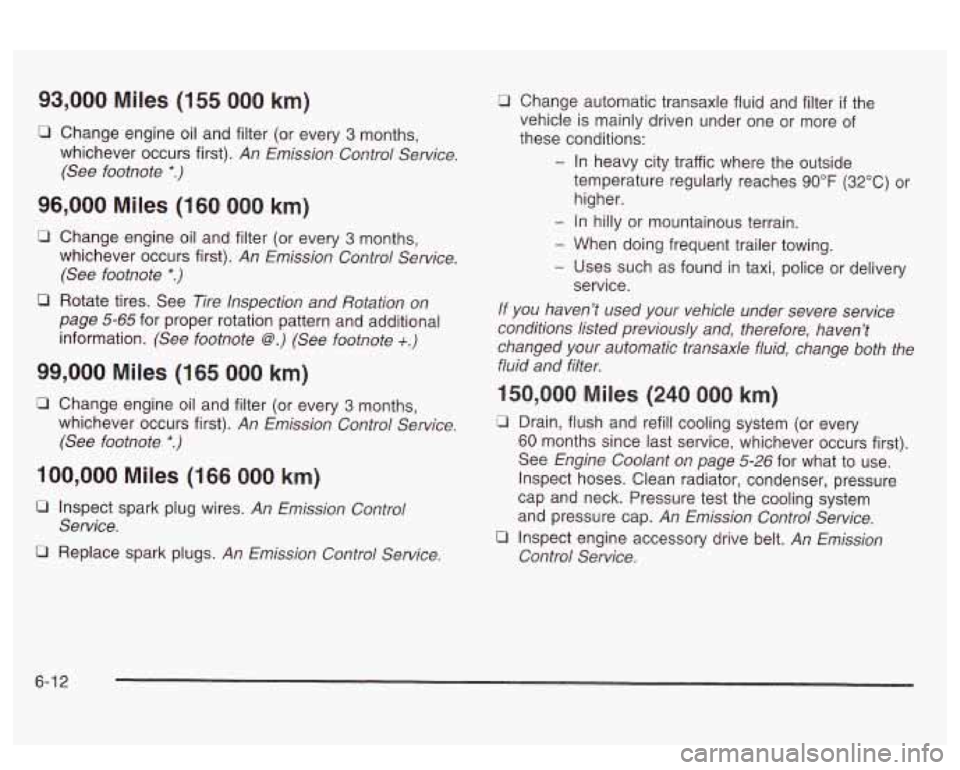
93,000 Miles (155 000 km)
0 Change engine oil and filter (or every 3 months,
whichever occurs first).
An Emission Control Service.
(See footnote
*.)
96,000 Miles (160 000 km)
Q Change engine oil and filter (or every 3 months,
whichever occurs first).
An Emission Control Service.
(See footnote
*.)
0 Rotate tires. See Tire Inspection and Rotation on
page
5-65 for proper rotation pattern and additional
information.
(See footnote @.) (See footnote +.)
99,000 Miles (165 000 km)
0 Change engine oil and filter (or every 3 months,
whichever occurs first).
An Emission Control Service.
(See footnote
*.)
100,000 Miles (166 000 km)
0 Inspect spark plug wires. An Emission Control
Service.
0 Replace spark plugs. An Emission Control Service.
0 Change automatic transaxle fluid and filter if the
vehicle is mainly driven under one or more of
these conditions:
- In heavy city traffic where the outside
temperature regularly reaches
90°F (32°C) or
higher.
- In hilly or mountainous terrain.
- When doing frequent trailer towing.
- Uses such as found in taxi, police or delivery
service.
If you haven’t used your vehicle under severe service
conditions listed previously and, therefore, haven’t
changed your automatic transaxle fluid, change both the
fluid and filter.
150,000 Miles (240 000 km)
0 Drain, flush and refill cooling system (or every
60 months since last service, whichever occurs first).
See
Engine Coolant on page 5-26 for what to use.
Inspect hoses. Clean radiator, condenser, pressure
cap and neck. Pressure test the cooling system
and pressure cap.
An Emission Control Service.
0 Inspect engine accessory drive belt. An Emission
Control Service.
6-13
Page 374 of 418
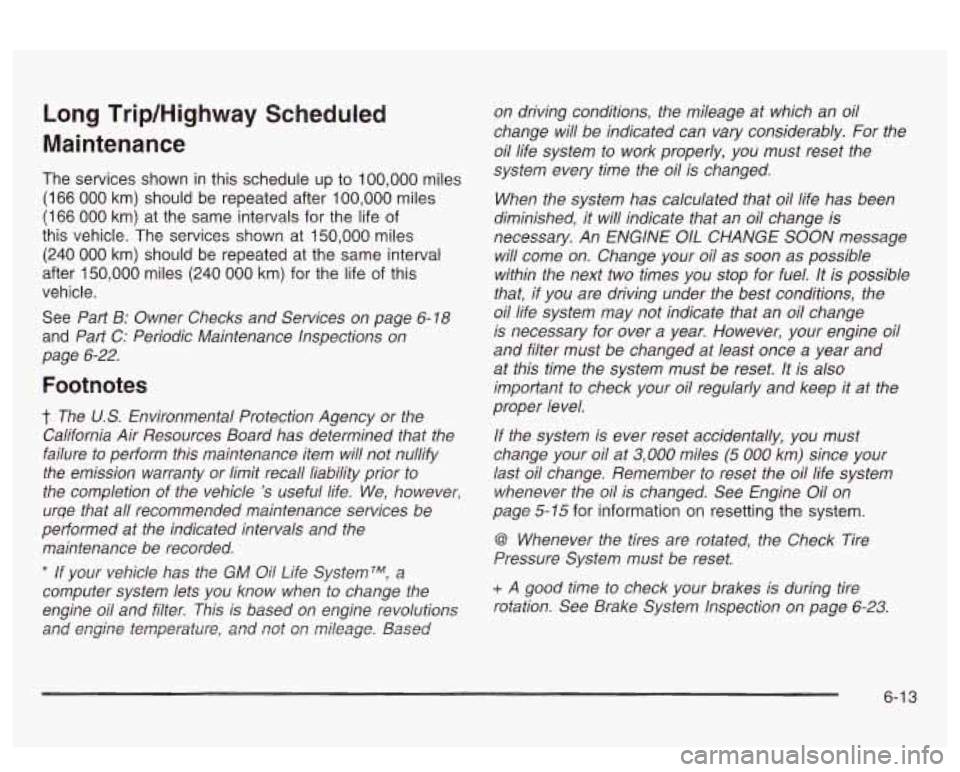
Long Trip/Highway Scheduled
Maintenance
The services shown in this schedule up to 100,000 miles
(166
000 km) should be repeated after 100,000 miles
(1 66 800 km) at the same intervals for the life of
this vehicle. The services shown at 150,000 miles
(240 000 km) should be repeated at the same interval
after 150,000 miles
(240 000 km) for the life of this
vehicle.
See
Part B: Owner Checks and Services on page 6-18
and Part C: Periodic Maintenance Inspections on
page 6-22.
t The U.S. Environmental Protection Agency or the
California Air Resources Board has determined that the
failure to perform this maintenance item will not nullify
the emission warranty or limit recall liability prior to
the completion of the vehicle
's useful life. We, however,
urqe that all recommended maintenance services be
performed at the indicated intervals and the
maintenance be recorded.
* If your vehicle has the GM Oil Life SystemTM, a
computer system lets you know when to change the
engine oil and filter. This is based on engine revolutions
aiid eiigifie telvpei-atdre, and ncf c:: ml?eage. Based
on driving conditions, the mileage at which an oil
change will be indicated can vary considerably. For the
oil life system to work properly, you must reset the
system every time the oil is changed.
When the system has calculated that oil life has been
diminished, it wil! indicate that an oil change is
necessary. An ENGINE
OIL CHANGE SOON message
will come on. Change your oil as soon as possible
within the next two times you stop for fuel. It is possible
that, if you are driving under the best conditions, the
oil life system may not indicate that an oil change
is necessary for over a year. However, your engine
oil
and filter must be changed at least once a year and
at this time the system must be reset. It is also
important to check your oil regularly and keep it at the
proper level.
If the system is ever reset accidentally, you must
change your oil at
3,000 miles (5 000 km) since your
last oil change. Remember to reset the oil life system
whenever the oil is changed. See Engine Oil on
page
5-75 for information on resetting the system.
@ Whenever the tires are rotated, the Check Tire
Pressure System must be reset.
+ A good time to check your brakes is during tire
rotation. See Brake System Inspection on page
6-23.
6-1 3
Page 379 of 418
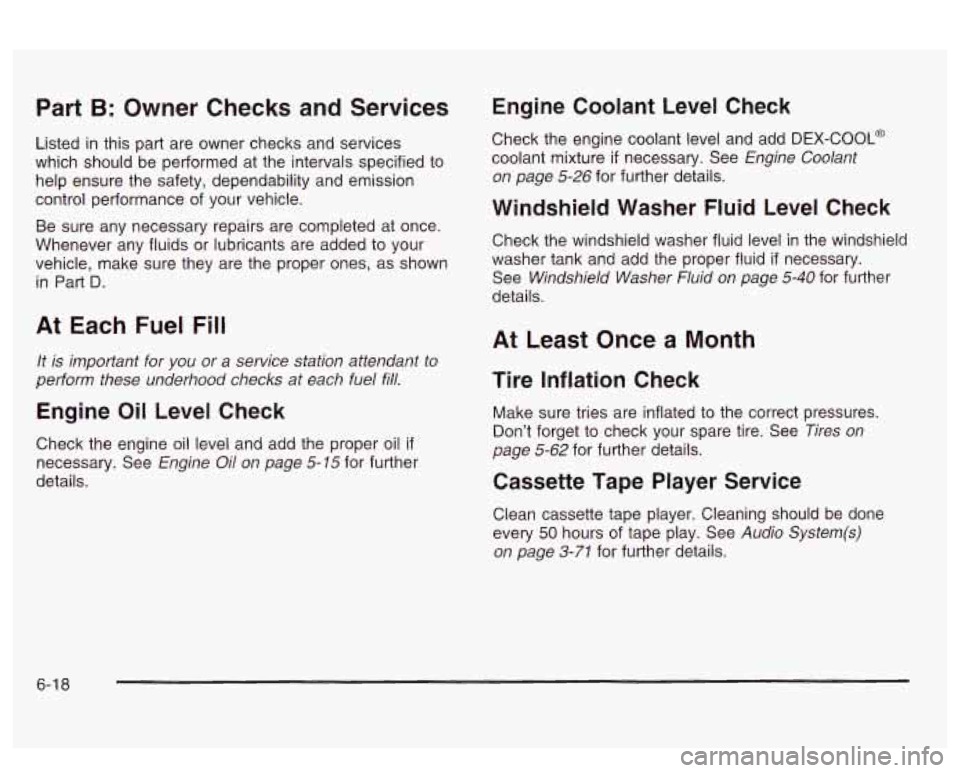
Part B: Owner Checks and Services
Listed in this part are owner checks and services
which should be perFormed at the intervals specified to
help ensure the safety, dependability and emission
control performance of your vehicle.
Be sure any necessary repairs are completed at once.
Whenever any fluids or lubricants are added to your
vehicle, make sure they are the proper ones, as shown
in Part D.
At Each Fuel Fill
It is important for you or a service station attendant to
perform these underhood checks at each fuel fill.
Engine Oil Level Check
Check the engine oil level and add the proper oil if
necessary. See Engine Oil on page 5-75 for further
details.
Engine Coolant Level Check
Check the engine coolant level and add DEX-COOL@
coolant mixture
if necessary. See Engine Coolant
on page 5-26
for further details.
Windshield Washer Fluid Level Check
Check the windshield washer fluid level in the windshield
washer tank and add the proper fluid
if necessary.
See
Windshield Washer Fluid on page 5-40 for further
details.
At Least Once a Month
Tire Inflation Check
Make sure tries are inflated to the correct pressures.
Don’t forget to check your spare tire. See
Tires on
page 5-62
for further details.
Cassette Tape Player Service
Clean cassette tape player. Cleaning should be done
every
50 hours of tape play. See Audio System(s)
on page
3-77 for further details.
6-1 8
Page 402 of 418
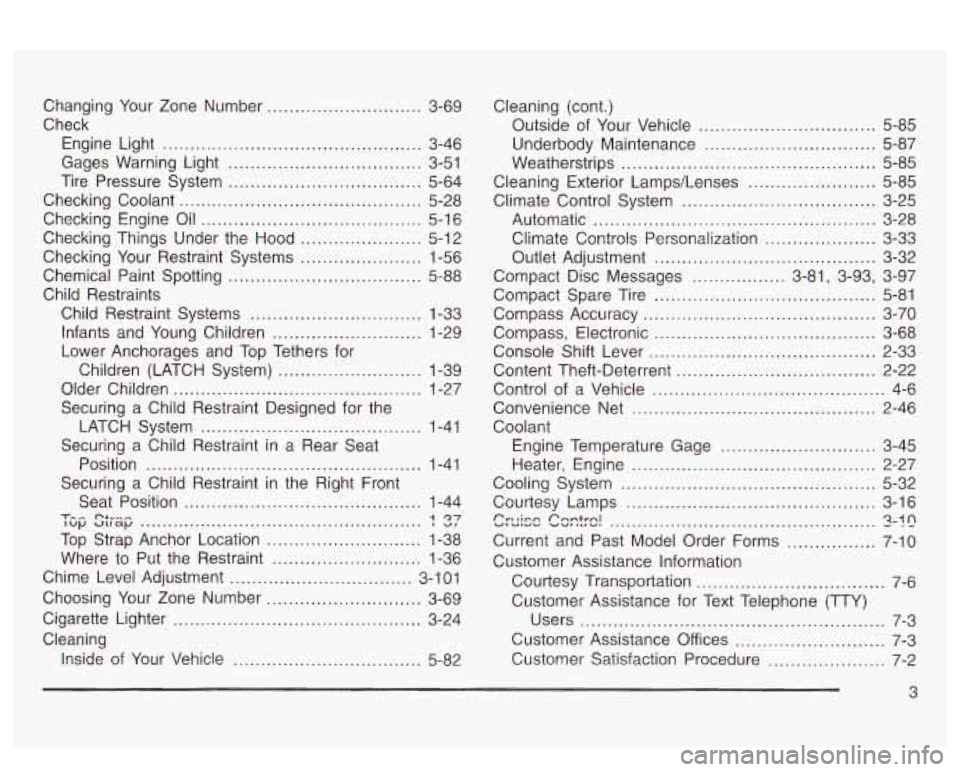
Changing Your Zone Number ............................ 3-69
Check Engine Light
............................................... 3-46
Tire Pressure System
................................... 5-64
Gages Warning Light
................................... 3-51
Checking Coolant
......................................... 5-28
Checking Engine Oil
...................... ... 5-16
Checking Things Under the Hood
.... ... 5-12
Checking Your Restraint Systems
...................... 1-56
Chemical Paint Spotting
................................... 5-88
Child Restraints Child Restraint Systems
............................... 1-33
Infants and Young Children
........................... 1-29
Lower Anchorages and Top Tethers for
Children (LATCH System)
.......................... 1-39
Older Children
............................................. 1-27
Securing a Child Restraint Designed for the
LATCH System
........................................ 1-41
Securing a Child Restraint in a Rear Seat
Position
.................................................. 1-41
Securing a Child Restraint in the Right Front
Seat Position
........................................... 1-44
IU~J duap ........................................ ... 1 3?
Top Strap Anchor Location ................. ... 1-38
Where to Put the Restraint
........................... 1-36
Chime Level Adjustment
................................. 3-101
Choosing Your Zone Number
............................ 3-69
Cleaning
-r-- C*" -.-
Cigarette Lighter ......................................... 3-24
Inside of Your Vehicle
.................................. 5-82 Cleaning
(cont.)
Outside of Your Vehicle
................................ 5-85
Underbody Maintenance
............................... 5-87
Weatherstrips
.............................................. 5-85
Cleaning Exterior LampdLenses
.... ............ 5-85
Climate Control System
................................ 3-25
Automatic
................................................... 3-28
Climate Controls Personalization .................... 3-33
Outlet Adjustment
........................................ 3-32
Compact Disc Messages
................. 3-81, 3-93, 3-97
Compact Spare Tire
........................................ 5-81
Compass Accuracy
.......................................... 3-70
Compass, Electronic
........................................ 3-68
Console Shift Lever
......................................... 2-33
Content Theft-Deterrent
.................................... 2-22
Control
of a Vehicle .......................................... 4-6
Convenience Net
............................................ 2-46
Coolant Engine Temperature Gage
............................ 3-45
Heater, Engine
............................................ 2-27
Cooling System
.............................................. 5-32
Courtesy Lamps
............................................. 3-16
VIUIL)" VVII.,", ................................................ 3-!Q
Current and Past Model Order Forms ................ 7-10
Customer Assistance Information
Crl I;cn Cnntrnl
Courtesy Transportation .................................. 7-6
Customer Assistance for Text Telephone (TTY)
Users
....................................................... 7-3
Customer Assistance
Off ices ........................... 7-3
Customer Satisfaction Procedure
..................... 7-2
3